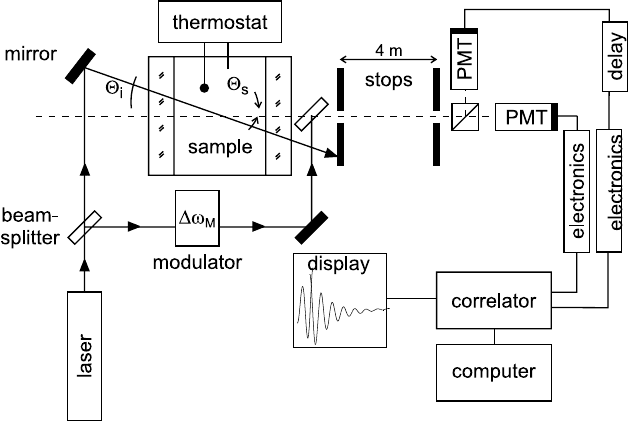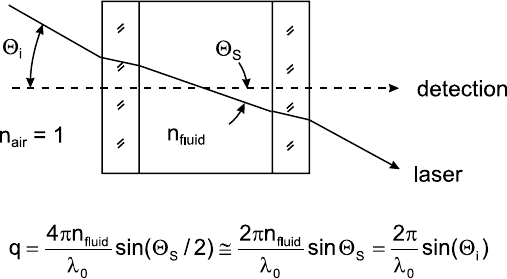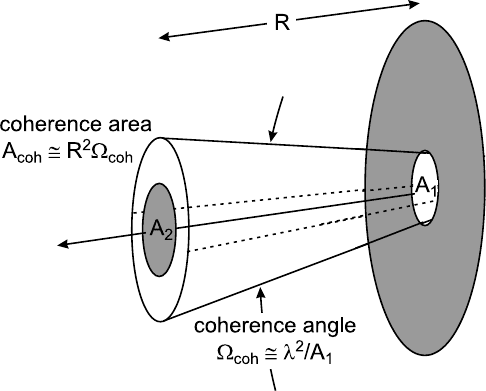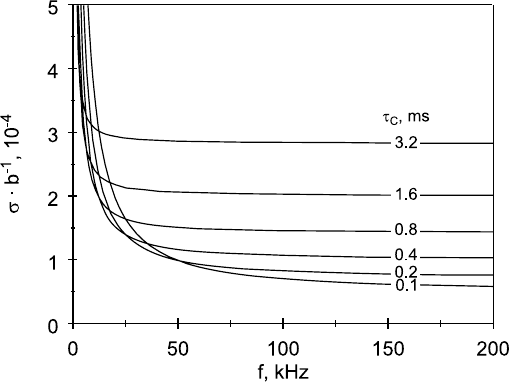Heitjans P., Karger J. (Eds.). Diffusion in Condensed Matter: Methods, Materials, Models
Подождите немного. Документ загружается.


590 Alfred Leipertz and Andreas P. Fr¨oba
Fig. 15.6. Possible setup for a dynamic light scattering experiment.
of two circular stops, onto a detector, conventionally a photomultiplier tube.
The signal is amplified, discriminated and fed into the correlator, a special
purpose computer for the computation of the ACF. After this generalized
scheme the individual parts shall be given some more discussion.
Laser
The choice of the suitable laser, which should be linearily polarized with
orientation of the E vector perpendicular to the scattering plane for usual
applications, is mainly determined by the scattering cross section of the fluc-
tuations to be investigated. Low-power He-Ne or semiconductor lasers are
in most cases sufficient for measurements of particle diffusion coefficients or
phenomena close to critical points. More powerful lasers with an output of
typically several hundreds of milliwatts are required for measurements, e.g.,
of the thermal diffusivity, where conventionally Argon lasers have been used,
but where also more recent types of solid-state lasers may be employed.
Which laser may be used also depends on the detection scheme applied.
In heterodyne detection the reference beam has to be added coherently on
the detector. Thus, the coherence length of the laser must be large enough to
ensure that the experiment is not affected by possibly different path lengths
of the main and the reference part of the light. The laser should therefore only
exhibit a single longitudinal mode, which may be accomplished by inserting
an intra-cavity etalon into gas lasers.

15 Diffusion Measurements in Fluids by Dynamic Light Scattering 591
Illuminating Optics
Generally, an important feature of the illuminating optical system is that
the laser beam should be focused strongly [12, 13], as it can be shown that
the signal-to-noise ratio may be improved by reducing the spot size of the
laser. Basically, the increased irradiance is balanced by the reduced size of
the scattering volume, but as it is possible to reduce the size of stops in the
receiving system simultaneously, a net effect results. The major disadvantage
or limitation of focusing is the lack of definition in the scattering vector,
as now - in a simplified picture - light is incident from various angles, which
results in an overlay of several correlation functions. This point is very critical
for the measurement of the sound attenuation and will be discussed below.
The scattering vector and thus the scattering angle to be reasonably em-
ployed are mainly determined by the process to be investigated. Small scatter-
ing angles result in a small linewidth and accordingly in a comparatively long
decay time. For a DLS analysis especially of the Brillouin lines it is necessary
to realize a small scattering angle in order to obtain reasonable time scales
in the computation of the ACF and for signal statistics. Conversely, slow
diffusion processes like particle diffusion are favourably analysed with large
scattering angles up to a backscattering geometry. For a survey, linewidths
and decay times for various scattering angles are given in Table 15.1 for the
individual processes and liquid values, which may be regarded as typical in
the order of magnitude.
For the determination of the scattering vector the refractive index of the
sample must be known which is in general not found tabulated for all samples,
thermodynamic states, and wavelengths used. One can solve this problem by
actually measuring the refractive index by using the refractions between the
external medium and the sample [14, 15]. Another possibility is to make use
of the approximation sin (Θ
S
/2) ≈ (1/2) sin Θ
S
and to replace, according to
Snell’s law, the resulting term n sin Θ
S
in the expression for the scattering
vector by sin Θ
i
,whereΘ
i
is the external angle of incidence and the refractive
index of the surrounding medium is assumed to be 1 (cf. Fig. 15.7). This
Table 15.1. Typical values for linewidths and decay times in the Rayleigh-Brillouin
spectrum. For the Rayleigh lines the subscripts denote thermal diffusivity (t), mu-
tual diffusion (12) and particle diffusion (p).
θ
q/m
−1
Γ
B
τ
B
Γ
t
τ
t
Γ
12
τ
12
Γ
p
τ
p
2
◦
5.8·10
5
682 kHz 1.5 µs 14 kHz 73 µs 682 Hz 1.5 ms 1.4 Hz 730 ms
5
◦
1.5·10
6
4.3 MHz 235 ns 85 kHz 12 µs 4.3 kHz 235 µs 8.5 Hz 117 ms
20
◦
5.8·10
6
68 MHz 15 ns 1.4 MHz 740 ns 68 kHz 15 µs 135 Hz 7.4 ms
90
◦
2.4·10
7
1.1 GHz 0.89 ns 22 MHz 45 ns 1.1 MHz 892 ns 2.2 kHz 446 µs
180
◦
3.3·10
7
2.2 GHz 0.45 ns 45 MHz 22 ns 2.2 MHz 446 ns 1.1 kHz 223 µs

592 Alfred Leipertz and Andreas P. Fr¨oba
Fig. 15.7. Determination of the modulus of the scattering vector in the small-angle
approximation.
approximation is very useful for small scattering angles [16], but naturally
cannot be used for larger ones.
An exact solution, which may be used for all scattering angles, is a spe-
cial symmetrical setup of the experiment [13]. Again, the a priori unknown
quantities (sample refractive index and scattering angle) may be replaced by
the refractive index of the surrounding medium and the angle of incidence.
Sample Cell
The range of possible sample cells is very broad due to the variety of appli-
cations, and the actual choice depends on the scattering angle and the path
length within the cell to be used. For small scattering angles typically cylindri-
cal cells are employed, where the main body may be made of metal for higher
pressure applications, and optical access is provided through cylindrical en-
trance and exit windows. If larger scattering angles are needed, especially for
the measurement of particle diffusion coefficients, glass cuvettes with circu-
lar or rectangular cross sections are normally employed, where appropriate
modifications with the use of glass rings are done for measurements at higher
pressures. An important feature in many DLS systems is the use of an index-
matching fluid, i.e. of a liquid with a refractive index very close to that of the
glass materials employed, in order to suppress unwanted reflections. A more
extensive treatment of sample cell design with some specific examples may
be found in [8].
Detection Optics
As DLS probes the temporal evolution of the interference pattern caused by
fluctuations in a sample, it is essential to restrict the solid angle of detection in

15 Diffusion Measurements in Fluids by Dynamic Light Scattering 593
Fig. 15.8. Model for the coherence properties of the detection system; “full” spatial
coherence is achieved if the detector area A
2
is smaller than the coherence area A
coh
.
a way that the pattern of bright and dark speckles is not averaged out. Thus,
the receiving system must ensure that the degree of coherence is large enough
for a good modulation of the signal. In the simplest way, the choice of the
solid angle of detection is realized by two circular stops at a given distance
where the complex degree of coherence determining the contrast b in the
correlation function (15.24) is a function of stop diameter and distance [12]
(cf. Fig. 15.8). Recent approaches employ single-mode optical fibres, which
make use of the fact that only one mode of field is propagated and thus
enables a perfectly coherent registration [17].
Detector
The standard detector for DLS measurements is a photomultiplier tube,
which is operated in a photon-counting mode, i.e. it produces a stream of
pulses the frequency of which is proportional to the light flux impinging on
it. A fundamental problem encountered in the detection system is that pho-
tomultipliers give rise to spurious signals, e.g., there is an afterpulsing effect,
meaning that with a certain probability a detected photon may cause an-
other subsequent pulse with no relevance for the process investigated. An
elegant solution to get rid of this problem is to use a beam splitter just in
front of the detector, to employ two photomultipliers (see Fig. 15.6) instead
of a single one and to operate these in a cross-correlation mode [18]. This
approach ensures that there is only correlation for events both detectors see
simultaneously and spurious uncorrelated pulses in either photomultiplier are
594 Alfred Leipertz and Andreas P. Fr¨oba
not registered. This cross-correlation scheme turns out to be necessary when
fast fluctuations on a time-scale of microseconds and below are investigated,
but should not be employed with no actual need for it, as the signal usable is
reduced by a factor of two. An alternative to photomultipliers are avalanche
photo diodes, which must be operated in a special way and which exhibit a
higher quantum efficiency at longer wavelengths [19].
Correlator
Correlators are special-purpose computers which calculate correlation func-
tions in real-time. An important characteristic of correlators is the sample
time ∆τ, which is the time interval used to collect the detector pulses and
which determines the resolution of the correlation function. In former times,
correlators were bulky stand-alone machines with typically some hundred
channels with an identical sample time (single-tau structure). Today, cor-
relators are made in form of plug-in-cards for PCs, and, what is more im-
portant, they offer a more sophisticated scheme of sample-time distributions
(multiple-tau structure). A possible selection is that after a block of eight or
sixteen channels with a constant sample time, ∆τ is doubled after each subse-
quent block. With this quasi-logarithmic channel spacing, sample times span
a range from a few nanoseconds up to many seconds so that it is possible to
measure processes on a completely different time-scale simultaneously. With
the evolution of standard PCs it is also possible to use a fast data-acquisition
board and to compute the ACF by a normal software routine; sample-times
of nanoseconds, however, are still far away from realization in this way.
15.3.2 Signal Statistics and Data Evaluation
With DLS experiments one should always be well aware that one is prob-
ing statistical fluctuations. Therefore it is necessary to average over a large
number of independent events in order to be able to extract reliable informa-
tion from the ACF. It is thus essential to discuss the statistical properties of
correlation functions. Let us first consider the variance σ
2
i
of the correlator
channel i of a homodyne ACF, where x is the lag-time of the correlator chan-
nel in units of the decay time of the intensity ACF, i.e. x = τ/τ
C
, f is the
count rate, i.e. the number of detector pulses per second, and T is the total
duration of the experiment. With these abbreviations, the variance may be
approximately expressed by [20, 21]
σ
2
i
=
b
2
/T
#
τ
C
[1 + exp(−2x)(2x +1)+2b exp(−2x)(−2x − 3)
+8b exp(−x)] + 2b
−1
f
−1
[1 + exp(−2x)+2b exp(−x)]
+ b
−2
!
f
2
∆τ
i
"
−1
[1 + exp(−x)]
$
.
(15.27)

15 Diffusion Measurements in Fluids by Dynamic Light Scattering 595
Fig. 15.9. Standard deviation of the ACF at τ = τ
C
as a function of count rate
and decay time; here a correlator with a quasi-logarithmic sample time structure
has been assumed.
In this relationship the various sources of noise in correlation functions may
be identified. The first line reflects the statistical nature of the experiment
itself; this signal noise is proportional to the ratio of decay time and mea-
surement time and thus is reduced when averaging over a larger number of
independent events. The second line is a cross term, whereas the third line
reflects the imperfect detection, as photons impinging onto the detector only
result in a detected pulse with a certain probability given. This detection
noise dominates for small values of count rate and sample time; in this case
the channel variance is inversely proportional to ∆τ. This formula has some
consequences for the design of an experiment. Firstly, the scattering angle
should be chosen in a way that the resulting decay time is not too small in
order to ensure that during a sample time of interest there is a large number
of detected pulses to keep the detection noise at a low level. On the other
hand, if decay times are very large, little can be gained by increasing the
count rate of the experiment, e.g., by increasing the laser power, as in this
case the statistical nature of the experiment itself dominates. This saturation
effect is visualized in Fig. 15.9, where the standard deviation of the channel
at a lag time of one τ
C
, i.e. x = 1, is plotted against the count rate for various
values of τ
C
.
A central quantity for the evaluation of correlation functions is the decay
time τ
C
. In order to be able to extract this quantity with high accuracy, it
is desirable to ensure experimental conditions where the ACF takes the form
of a simple exponential. A curve of form y = a + b exp(−τ/τ
C
) is then fitted
to the experimental ACF, which may be done using a non-linear algorithm

596 Alfred Leipertz and Andreas P. Fr¨oba
Fig. 15.10. Example for the multi-fit approach for the evaluation of correlation
functions taken at the refrigerant R143a in the saturated liquid phase (insert on
top left). The insert on bottom left shows the residuals of experimental data and
fit, which is free of systematic deviations. The inserts on top and bottom right show
the deviation of the decay times determined from the mean value, when the fit is
started at different times and is performed up to different lag times, respectively.
according to Marquard and Levenberg [22] and which requires to attribute
a correct statistical weight w
i
to each data point according to w
i
=(1/σ
i
)
2
.
In this context it is of great importance to make sure that the correlation
function actually matches the theoretical model; if this does not hold there
is a clear indication that the experiment cannot be relied on. A possible way
to perform this check is to transform the experimental correlation function
according to g
(2)
(τ) → ln[g
(2)
(τ) −1] and to fit a polynom to this expression.
In this method of cumulants [23] all orders higher than linear should vanish
for a pure exponential and from the quadratic and the linear cofficient a
quality factor may be built up to quantify deviations. However, there are two
major problems connected with this approach. Firstly, it relies on a value
of exactly one for the baseline; even small deviations, which may not affect
the measurement in the time interval of interest, may result in erroneously
bad values for the quality factor. Secondly, the transformation is basically
restricted to positive values of g
(2)
(τ) −1; with experimental noise given, the
cumulant expansion is restricted to a limited interval of lag times.
15 Diffusion Measurements in Fluids by Dynamic Light Scattering 597
A different approach, which overcomes these problems, is to fit an ex-
ponential to various lag time intervals [21]. The experimental ACF is only
regarded to match the theoretical form if the decay times obtained for these
different intervals agree within a certain value given. Moreover, the standard
deviation of the single fit may be regarded as a measure of quality, which
takes into account both the statistical quality of the experimental data and
possible systematic deviations. An example for this procedure is given in
Fig. 15.10.
Another important question is that for the time interval that should be
employed for the fit. If too many channels at large lag-times are omitted, there
will be a significant loss of information; if the fit is extended too much into
the background, noisy data without relevance are included. For the multi-fit
procedure it has turned out to be advantageous if a span of about 2−6 decay
times is regarded in the evaluation. This ensures that all relevant information
is included and that possible deviations from a single exponential can be
detected reliably.
15.4 Thermophysical Properties of Fluids Measured by
Dynamic Light Scattering
15.4.1 Thermal Diffusivity
The thermal diffusivity a is that transport property for which the devel-
opment of the DLS technique is probably most advanced and where mea-
surements can be carried out routinely over a wide range of temperature
and pressure for the liquid phase and, due to the lower signal levels, in an
extended vicinity of the critical point for the vapour phase [24–30]. What
makes the measurement of the thermal diffusivity particularly interesting is
the fact that it is hardly possible by any other technique than light scattering
to measure this property directly with comparable accuracy. Other methods
access the thermal conductivity λ = aρc
p
, which is related to the thermal
diffusivity a by the density ρ and the isobaric heat capacity c
p
.
With the exception of measurements in the vicinity of the critical point,
normally a heterodyne detection scheme is employed so that the correlation
function takes the simple form of (15.25). As the measurement of the thermal
diffusivity is performed at low scattering angles of about 2.5
◦
to 5
◦
an ac-
curate measurement of the angle of incidence is of major importance, which
may be performed by an autocollimation procedure. The main measuring de-
vice is a rotation table, which is placed above the sample cell. With a mirror
mounted on this table the laser beam can be reflected into the direction of
the source of the laser beam. First the optical axis of observation is defined
by aligning the laser beam through the stops, and the angle value is mea-
sured by autocollimation. Next the laser beam is adjusted to the angle of
incidence desired, and after another autocollimation the angle of incidence

598 Alfred Leipertz and Andreas P. Fr¨oba
Fig. 15.11. Thermal diffusivity of selected refrigerants on the saturation line [29,
30]; lower trace symbols: liquid; upper trace symbols: vapour.
can be obtained from the difference of the readings on the rotation table.
With an uncertainty in the angle measurement of order 0.01
◦
an uncertainty
in the thermal diffusivity of about 0.5% to 1% results.
The other major source of error is the determination of the decay time.
If the correlation function is free from systematical errors the uncertainty in
the determination of τ
C
is given by the signal and the experimental dura-
tion. Depending on the equipment used, the scattering cross section of the
fluctuations investigated and the time available for an experimental run, the
uncertainty for a single measurement is of order 1 − 3%. If several indepen-
dent experimental runs are performed, which is superior to running a single
experiment over a longer time, this value may of course be improved. Finally,
the uncertainty also depends on the definition of the thermodynamic state,
especially on the exact measurement of the sample temperature. In conclu-
sion, a total single-measurement uncertainty of 2.5%, as it was derived for
measurements on liquid toluene [27], may be regarded as typical.
There have been many applications on the determination of a for a wide
range of fluids. DLS has especially contributed to an improvement in the data
situation for refrigerants. An example is given in Fig. 15.11, where measure-
ments on new refrigerants with less environmental impact are shown.
Whereas the measurement of a in pure fluids is basically a straightforward
task, this is clearly more difficult in fluid mixtures. Even in the simplest case
of a binary fluid mixture and neglecting the Brillouin component, the ACF
takes the form

15 Diffusion Measurements in Fluids by Dynamic Light Scattering 599
Fig. 15.12. Thermal diffusivity of a mixture of benzene and toluene [31].
G
(2)
(τ)=(I
LO
+ I
t
+ I
c
)
2
background
+2I
LO
I
t
exp(−τ/τ
C,t
)+2I
LO
I
c
exp(−τ/τ
C,c
)
heterodyne term
+I
2
t
exp(−2τ/τ
C,t
)+I
2
c
exp(−2τ/τ
C,c
)
homodyne term
+2I
t
I
c
exp(−τ/τ
C,t
− τ/τ
C,c
)
cross term
(15.28)
where the subscripts t and c denote the contributions from temperature and
concentration fluctuations, respectively. With a large reference light contribu-
tion, I
LO
I
t
and I
LO
I
c
, the ACF simplifies to a sum of two exponentials
g
(2)
(τ)=a + b
1
exp(−τ/τ
C,t
)+b
2
exp(−τ/τ
C,c
). (15.29)
It is obvious that even for this simplified function the determination of the
decay time τ
C,t
is more complicated and associated with a higher degree of
uncertainty than in the case of a pure fluid, because a larger number of para-
meters are to be fitted. The situation becomes easier if the refractive indices
of the two components nearly match, as the signal from the concentration
fluctuations may then be treated as a low-amplitude perturbation. A pos-
sible approach [31] is to expand the exponential decay of the concentration
fluctuations in a way that an ACF of form
g
(2)
(τ)=a + b exp(−τ/τ
C,t
)+cτ (15.30)
results. The thermal diffusivity of a mixture of benzene and toluene measured
in that way is shown in Fig. 15.12.
It is also possible to measure a in mixtures with a larger difference in
refractive index. Naturally, this is connected with a loss of accuracy and
comes to a limit, when the signal due to temperature fluctuations is much
weaker than that by concentration fluctuations.
